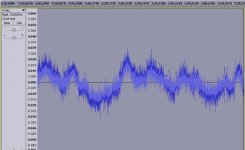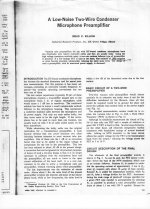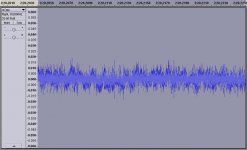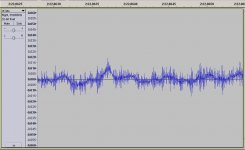Next step, comparing the DXD, 352, with 96, no 192 on offer: same story as with the other 2L sample recording ... the frequency content at well below ultrasonic is markedly different, peaks in the difference waveform spectrum are between 50 and 500Hz! Visually, amplitudes at up to only -30dB down.
As a flavour of the level of disparity, see below. Horizontal in seconds of course, vertical scale is expanded, goes to 1. So, 0.01 is -40dB down ...
Frank
As a flavour of the level of disparity, see below. Horizontal in seconds of course, vertical scale is expanded, goes to 1. So, 0.01 is -40dB down ...
Frank
Attachments
Last edited:
Dimitri, so what? Did you think of it too? Did you read Mead Killion's paper 40 years ago?
Not everything is obvious until it is pointed out. It is always obvious after the fact.
If you want to be helpful, find the equation for distortion from a mike capsule with a varying capacitance under vibration against a fixed load capacitance. I tried for about an hour, but to no avail. It is out there somewhere.
Not everything is obvious until it is pointed out. It is always obvious after the fact.
If you want to be helpful, find the equation for distortion from a mike capsule with a varying capacitance under vibration against a fixed load capacitance. I tried for about an hour, but to no avail. It is out there somewhere.
I'm so happy to read that, after all those years, fighting against the vinyl nostalgics.
At the very beginning of the digital recording, while so much sound engineers were talking of the DACs quality, i pretended that most of the audible differences were due to the analog stages after the DACs, not the DACs themselves.
Used a cheap Philips cd player with a Delta sigma 14 bits DAC followed by a modified analog stage to demonstrate-it in my studio.
For me, the difference between vinyl and digital (whatever the sampling rate/bits) is the same than Technicolor/high resolution digital movies.
Now, i can understand why some, like "our thread's Lord" can prefer the "The train arriving at La Ciotat station" From Louis Lumière to the last blog buster movie .
With the risk to be remembered as the "Master of the steam engines".
Would likke to add that, if, that the beginning of CDs, so many records were truly sounding "aggressive"; it was only due to aggressive tone correction done during mixing, to pre-compensate the vinyl losses.
Magic rooms were using studio monitors equalized to simulate as much as possible those losses, so what was in the tapes were good for vinyls (or on those monitors) and bad for strait digital.
The curtain between the original and the auditor introduced by the vinyl was nice too to mask some distortions and defects and good for increasing the place for our imaginations.
I remember how i was shocked by the poor sound quality when i first listened to the digital copy of the Beatles's "revolver" album, while it was so fantastic on the 1966 AM radio's programs !
Magic rooms were using studio monitors equalized to simulate as much as possible those losses, so what was in the tapes were good for vinyls (or on those monitors) and bad for strait digital.
The curtain between the original and the auditor introduced by the vinyl was nice too to mask some distortions and defects and good for increasing the place for our imaginations.
I remember how i was shocked by the poor sound quality when i first listened to the digital copy of the Beatles's "revolver" album, while it was so fantastic on the 1966 AM radio's programs !
Better nulling by applying an attenuation of -0.23dB to the 352 version, that's such a nice, obvious figure! So get a more reasonable looking balance at that precise point of the waveform. The trouble is, just down the road again there is some excess energy happening at other frequencies, as in the 2nd image.Okay, shut off the fire alarms: looks like I led myself astray, this might be all about fine tuning the scaling factor between different resolution versions, give me a chance to play with this a bit more -- 2L may be shiny clean as regards equalising ...
Frank
Also, looking at the spectrum the hump of the frequency makeup of the difference file is now centred at 1kHz, which is probably worse from the audibility POV -- still not happy!
Next step, do my own resampling of the 352 version, down to 96, then back up gain to 352, see what I get ...
Frank
Attachments
Especially output stages, but common cathode simple stages as well. It is very audible, but who cares?
It is nonsense, Pavel. You repeat others' words.
No, that is not the main reason, Wavebourn.
OK, time is up. The reason they bootstrapped the input resistors is to reduce effective input CAPACITANCE, in order to reduce distortion.
No way, John. Bootstrapping the resistor you are getting higher dynamic resistance. If you want to get lower gate-source capacitance you need to bootstrap the source, not the resistor.
Better nulling by applying an attenuation of -0.23dB to the 352 version, that's such a nice, obvious figure! So get a more reasonable looking balance at that precise point of the waveform. The trouble is, just down the road again there is some excess energy happening at other frequencies, as in the 2nd image.
Also, looking at the spectrum the hump of the frequency makeup of the difference file is now centred at 1kHz, which is probably worse from the audibility POV -- still not happy!
Next step, do my own resampling of the 352 version, down to 96, then back up gain to 352, see what I get ...
Frank
OK Keep going... we're listening and watching.
OK Keep going... we're listening and watching.
Thanks, Richard. OK, results are in and it worked as well as I expected it to. This resampling exercise is particularly stressful because the natural fit for downsampling 352.8 is to use 88.2kHz as the go between, rather than 96 as here.
So, did the resampling, down and up, of only the right channel, which appeared to be slightly more dynamic, making it mono on the way. Then, did a diff of the original, 2L waveform and the resultant, 2 pass 352.8 file. This was what came out:
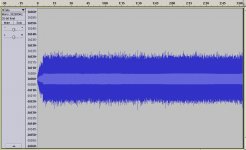
Looks pretty terrible, but then have a look at the spectrum:
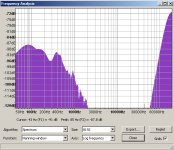
This is very suspicious, a typical noise shaping curve after 40kHz, suggests there is no real information beyond that frequency, it's purely processing "rubbish". So, apply equalisation to brickwall attenuate everything after 40kHz, and get this:
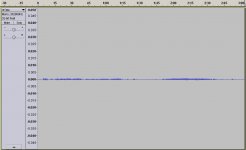
This looks much, much better, but there is still some apparent noise there. Can't zoom any more, so use the amplify function to boost it, by 50dB:
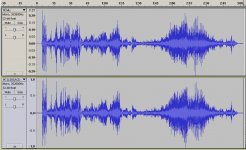
Lo and behold, we have our original waveform back, inverted, as demonstrated by the copy of the result of the 2 pass resampling which follows the amplified difference "noise". In other words, a slight attenuation crept in at some point, which is why the difference process didn't perfectly null -- easy to compensate for ...
Frank
Last edited:
OK Keep going... we're listening and watching.
I'm not at home so i cant check any of those files.
But sure you can write to 2L and ask Information on the process used and eventual editing.
Thanks for the good work, Frank also from me.
Frank, so from what I understand they have recorded armonics up to 40khz.
If I'm correct, this is still VERY good. I personally believe that we should aim for 50khz, and that should sound MUCH better than brick walled at 20-21k. With most modern tweeters reaching 40k this should be clearly audible.
I used their piano sonata and while that shouldn't have any harmonic above 20k, the DXD version was do much closer to the real thing...
If I'm correct, this is still VERY good. I personally believe that we should aim for 50khz, and that should sound MUCH better than brick walled at 20-21k. With most modern tweeters reaching 40k this should be clearly audible.
I used their piano sonata and while that shouldn't have any harmonic above 20k, the DXD version was do much closer to the real thing...
The point of the exercise I did is that sampling at 96kHz, or even 88.2 was sufficient to encode all the musical, or event information of the DXD recordings that I tested from 2L. The DXD recording process theoretically can capture real audio information up to 176kHz but I haven't seen any evidence so far that the 2L crowd have done that for frequencies over 40kHz.Frank, so from what I understand they have recorded armonics up to 40khz.
If I'm correct, this is still VERY good. I personally believe that we should aim for 50khz, and that should sound MUCH better than brick walled at 20-21k. With most modern tweeters reaching 40k this should be clearly audible.
I used their piano sonata and while that shouldn't have any harmonic above 20k, the DXD version was do much closer to the real thing...
Which means, why do you need 352, 176, 192, etc? More space, download time, etc.
Yes, playback can sound better at the higher sampling rates, but my experiments indicate that this is a by-product of the way the playback systems work -- not because you're hearing "more information" ...
Frank
Here is some additional stuff on 30ips analog recorders. Please note date.
Thanks, John! I will study it with great interest.
.....
At the very beginning of the digital recording, while so much sound engineers were talking of the DACs quality, i pretended that most of the audible differences were due to the analog stages after the DACs, not the DACs themselves.
Used a cheap Philips cd player with a Delta sigma 14 bits DAC followed by a modified analog stage to demonstrate-it in my studio.
.......
1. First Philips CD players weren't cheap.
2. They were 14 Bit Multi-Bit, not Delta-Sigma.
The point of the exercise I did is that sampling at 96kHz, or even 88.2 was sufficient to encode all the musical, or event information of the DXD recordings that I tested from 2L. The DXD recording process theoretically can capture real audio information up to 176kHz but I haven't seen any evidence so far that the 2L crowd have done that for frequencies over 40kHz.
Which means, why do you need 352, 176, 192, etc? More space, download time, etc.
Yes, playback can sound better at the higher sampling rates, but my experiments indicate that this is a by-product of the way the playback systems work -- not because you're hearing "more information" ...
Frank
Yes, I agree on your conclusions.
Now, why higher (than 88.2 which is min to preserve what current mics can acquire, at least those from 2L) sampling rate sounds better if the HF content is the same?
Somebody said earlier in this thread "noise", and I agree - pushing the hf noise further makes it less audible (by whichever mechanism the ear/brain use).
DAD (digital audio Denmark) affirms that 352k are required to get away with filtering. Considering the damage that analog filtering does to the music signal I agree with them. (Sorry no DBT done).
Chord believes that 1,5mhz are needed instead. I can't verify that because no multibit dac exist that can support such sampling rates.
The most sound way to reproduce digital would be using 88,2k material of good quality (ie non manipulated more than redbook) and upsample it on the fly to at least 352k, and get rid of analog filtering, or at least push it very high (>300k) where it won't destroy phase coherence up to 40khz.
If someone wants to organize blind tests, I'm all in favour of them.
Which means, why do you need 352, 176, 192, etc? More space, download time, etc.
Recommended reading:
http://www.lavryengineering.com/pdfs/lavry-white-paper-the_optimal_sample_rate_for_quality_audio.pdf
- Status
- Not open for further replies.
- Home
- Member Areas
- The Lounge
- John Curl's Blowtorch preamplifier part II
